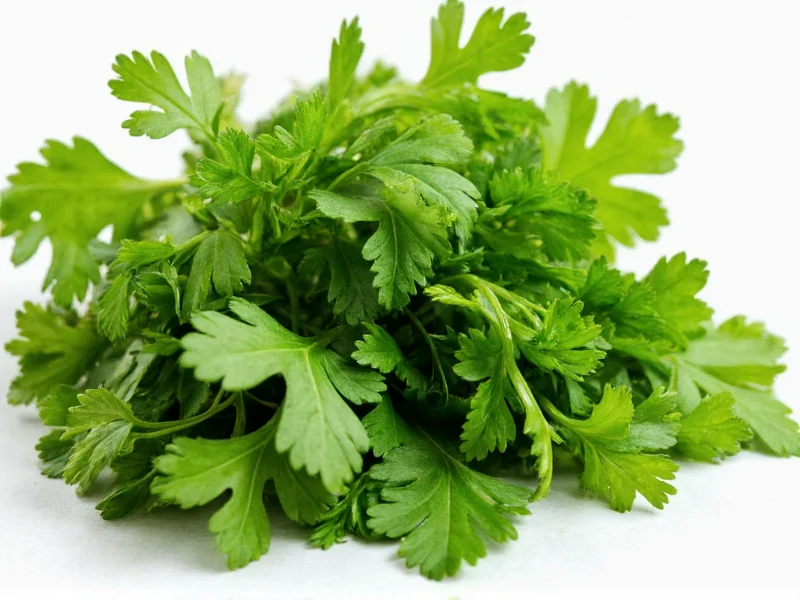When you're in the middle of cooking and realize you've run out of parsley, knowing reliable alternatives can save your recipe. Whether you need a garnish substitute or an ingredient replacement for cooking, understanding the flavor profiles and best applications of each alternative is crucial for maintaining your dish's intended taste and appearance.
Understanding Parsley's Role in Cooking
Parsley serves multiple purposes in culinary applications. Flat-leaf (Italian) parsley offers a clean, slightly peppery flavor ideal for cooking, while curly parsley provides visual appeal as a garnish with milder flavor. When seeking a substitute for fresh parsley in recipes, consider whether you need it for flavor contribution or visual presentation, as this determines the best alternative.
Top Parsley Substitutes and Their Best Uses
Not all parsley alternatives work equally well in every situation. The right herb substitute when you don't have parsley depends on your specific culinary application.
Cilantro: The Closest Fresh Alternative
Cilantro shares parsley's fresh, bright quality with a citrusy note that works well in many applications. Use it as a 1:1 replacement for flat-leaf parsley in salsas, salads, and Middle Eastern dishes. Be cautious with strong-flavored varieties, as some people detect a soapy taste due to genetic factors. This makes cilantro an excellent substitute for parsley in tabbouleh for those who enjoy its flavor profile.
Dried Parsley Flakes: The Pantry Staple
When fresh isn't available, dried parsley provides convenience. Use one-third the amount of dried parsley compared to fresh (1 teaspoon dried = 1 tablespoon fresh). While it lacks the vibrant color and full flavor of fresh, it works well in soups, stews, and sauces where appearance matters less. This is your go-to dried parsley replacement option for everyday cooking.
| Substitute | Best For | Ratio | Flavor Notes |
|---|---|---|---|
| Cilantro | Fresh applications, salsas, tabbouleh | 1:1 | Citrusy, can be soapy to some |
| Dried Parsley | Soups, stews, sauces | 1 tsp dried = 1 tbsp fresh | Milder, less vibrant |
| Chervil | Eggs, delicate sauces, fines herbes | 1:1 | Anise-like, subtle |
| Celery Leaves | Garnishing, salads | 1:1 | Mild celery flavor |
| Dried Oregano | Mediterranean dishes, tomato-based sauces | 1/2 tsp dried = 1 tbsp fresh parsley | Stronger, earthier |
Chervil: The Delicate Alternative
Often called "gourmet parsley," chervil has a mild anise flavor that works beautifully in French cuisine. It's perfect for egg dishes, delicate sauces, and as part of the classic fines herbes blend. Use it as a 1:1 replacement where you want parsley's appearance without its slightly bitter note. This makes chervil an ideal fresh parsley alternative for garnishing sophisticated dishes.
Celery Leaves: The Underrated Option
Don't discard those leafy tops! Celery leaves offer a mild celery flavor with visual similarity to parsley. They work well in salads, potato salads, and as garnish. The flavor is milder than parsley, so use slightly more (about 1.5 times the amount). This is an excellent zero-waste substitute for parsley in potato salad where both ingredients complement potatoes beautifully.
Dried Oregano: For Robust Applications
When cooking Mediterranean dishes that call for parsley, dried oregano can provide similar earthy notes with more intensity. Use half the amount you would fresh parsley, as oregano's flavor concentrates when dried. This works particularly well as a substitute for parsley in soup bases and tomato-based sauces where the stronger flavor holds up during cooking.
Special Considerations for Specific Dishes
Certain recipes have unique requirements that affect your choice of substitute for fresh parsley in recipes.
Middle Eastern Dishes
For tabbouleh or fattoush, cilantro makes the closest substitute, though the flavor profile shifts noticeably. If you're sensitive to cilantro's soapy notes, try a combination of mint and dill (use half mint, half dill to replace parsley) which maintains the fresh quality while providing complexity.
French Cuisine
Traditional French preparations often rely on parsley's mild flavor. Chervil works best here, but if unavailable, a small amount of tarragon (use one-third the amount) can provide similar complexity without overwhelming the dish. This is crucial when seeking a substitute for parsley in beurre blanc or other delicate sauces.
Italian Cooking
In Italian dishes where parsley appears in gremolata or as a finishing herb, try a combination of basil and oregano. Use two parts basil to one part oregano to approximate parsley's flavor profile without dominating the dish. This blend works well as a substitute for parsley in pasta dishes where visual appeal matters less than flavor balance.
Dietary and Allergy Considerations
Some people need parsley alternatives due to allergies or dietary restrictions. For those with non-allergic alternatives to parsley needs, consider:
- For Apiaceae family allergies: Mint or basil provide safe alternatives with different botanical families
- For low-potassium diets: Chives offer similar visual appeal with significantly less potassium
- For histamine intolerance: Fresh chervil is generally better tolerated than parsley
When Substitution Isn't Recommended
While many dishes tolerate parsley substitutes well, some preparations rely on parsley's unique qualities. Traditional persillade (garlic and parsley mixture) loses its character with substitution, and certain seafood presentations depend on parsley's specific visual contrast. In these cases, it's better to omit parsley entirely than use an inappropriate substitute.
Storage Tips for Parsley Alternatives
Maximize the shelf life of your parsley substitutes:
- Store fresh alternatives like cilantro and chervil in a glass of water in the refrigerator, covered with a plastic bag
- Freeze celery leaves in ice cube trays with olive oil for ready-to-use cooking portions
- Keep dried herbs in airtight containers away from light and heat
- Revive wilted substitutes by soaking in ice water for 15 minutes











 浙公网安备
33010002000092号
浙公网安备
33010002000092号 浙B2-20120091-4
浙B2-20120091-4